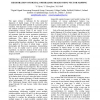Free Online Productivity Tools
i2Speak
i2Symbol
i2OCR
iTex2Img
iWeb2Print
iWeb2Shot
i2Type
iPdf2Split
iPdf2Merge
i2Bopomofo
i2Arabic
i2Style
i2Image
i2PDF
iLatex2Rtf
Sci2ools
89
Voted
ICIP
2000
IEEE
2000
IEEE
Registration of Digital Ophthalmic Images Using Vector Mapping
This paper outlines a technique for the automated alignment of digital images of the retina under the assumption that they differ spatially by a geometric global transform. This alignment is a form of image registration. The solution is based on generating vectors from known, predominantly common points in the images to be registered. All potential transforms between the vectors are generated, with the correct registration producing a tight cluster of data points in the space of transform coefficients. This cluster is identified using the Expectation Maximization (EM) algorithm, and the optimum global transform calculated. The technique has been applied to two types of retinal image ? optical photographs and fluorescein angiograms, demonstrating that it can be readily used to provide cross-modal registration. An objective analysis of this system is also outlined, and examples of an application to real clinical images presented.
Geometric Global Transform | ICIP 2000 | Image Processing | Optimum Global Transform | Transform Coefficients |
Related Content
| Added | 25 Oct 2009 |
| Updated | 25 Oct 2009 |
| Type | Conference |
| Year | 2000 |
| Where | ICIP |
| Authors | Neil Ryan, Conor Heneghan, M. Cahill |
Comments (0)

